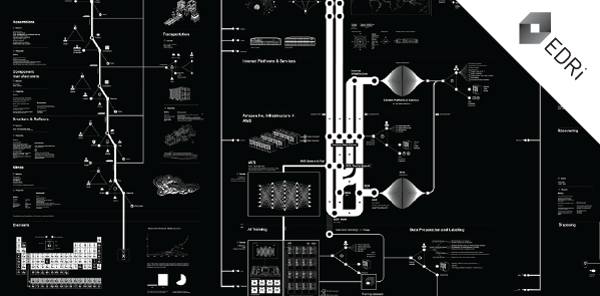Anatomy of an AI system – from the Earth’s crust to our homes
The Internet of Things (IoT) and the numerous devices that surround us and let us get through our daily routine with more convenience are becoming more advanced.
A “smart” home is not a futuristic notion anymore – it is reality. However, there is another side to this convenient technology: the one that exploits material resources, human labor, and data.

In their latest research, Kate Crawford from New York University AI Now Institute, a research institute examining the social implications of artificial intelligence (AI), and Vladan Joler from EDRi member SHARE Foundation’s SHARE Lab have analysed the extraction of resources across time – represented as a visual description of the birth, life and death of a single Amazon Echo unit. The interlaced chains of resource extraction, human labor and algorithmic processing across networks of mining, logistics, distribution, prediction and optimisation make the scale of this system almost beyond human imagining. The whole process is presented on a detailed large-resolution map.
It is easy to give Alexa a command – you just need to say “play music”, “read my last unread email” or “add milk to my shopping list” – but this small moment of convenience requires a vast planetary network, fuelled by the extraction of non-renewable materials, labour, and data. The scope is overwhelming: hard labour in mines for extracting the minerals that form the physical basis of information technologies, strictly controlled and sometimes dangerous hardware manufacturing and assembly processes in Chinese factories, outsourced cognitive workers in developing countries labelling AI training data sets, all the way to the workers at toxic waste dumps. All these processes create new accumulations of wealth and power, which are concentrated in a very thin social layer.
These extractive processes have an enormous toll in terms of pollution and energy consumption, although it is not visible until you scratch the surface. Also, many aspects of human behaviour are being recorded, quantified into data and used to train AI systems and enclosed as “intellectual property”. Many of the assumptions about human life made by machine learning systems are narrow, normative and laden with errors, yet they are inscribing and building those assumptions into a new world, and will increasingly play a role in how opportunities, wealth, and knowledge are distributed.
Anatomy of an AI system
https://anatomyof.ai/
Map: Anatomy of an AI system
https://anatomyof.ai/img/ai-anatomy-map.pdf
(Contribution by Bojan Perkov, EDRi member SHARE Foundation, Serbia)


